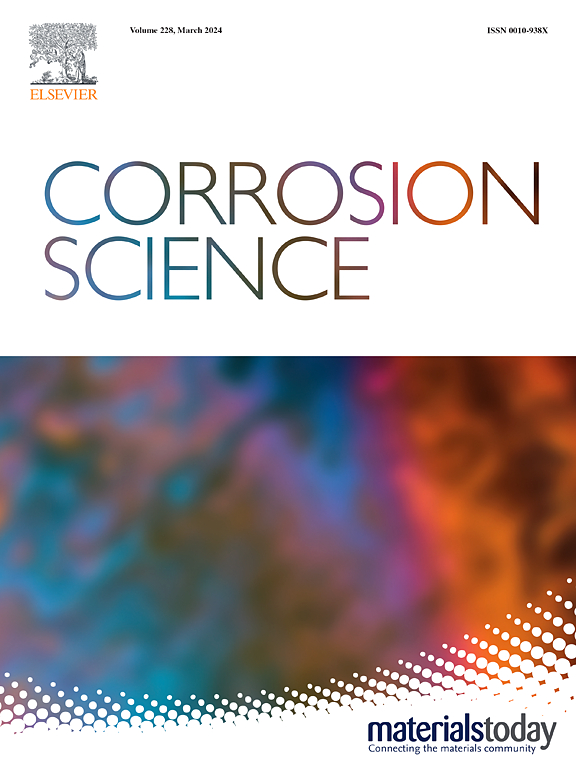硬质阳极氧化对摩擦腐蚀条件下铝合金机械和电化学特性的影响
IF 7.4
1区 材料科学
Q1 MATERIALS SCIENCE, MULTIDISCIPLINARY
引用次数: 0
摘要
本研究调查了硬质阳极氧化对摩擦腐蚀条件下铝合金机械和电化学特性的影响。与干燥条件相比,摩擦腐蚀条件下铝合金的摩擦系数增大,而硬质阳极氧化试样的摩擦系数减小。这归因于溶液中的腐蚀性离子腐蚀了硬质阳极氧化试样的对体和三膜的转移膜。在摩擦腐蚀条件下进行的电位极化实验中,铝合金在施加负载时表现出很高的电流密度。然而,当电位高于 -0.05 V 时,电流密度下降并发生逆转。这被认为是由于腐蚀离子优先与产生的磨损碎片发生反应,从而减少了与磨损轨迹的氧化反应。然而,硬质阳极氧化试样的电流密度随着负载和电位的增加而增加。此外,在摩擦腐蚀条件下,磨损宽度和深度的增加率也很明显(宽度:42.65 %,深度:32.63 %)。这是由于摩擦/磨损过程中产生的气穴和流体冲击加速了脆性和多孔性硬阳极氧化膜的开裂和损坏。不过,硬质阳极氧化铝合金的耐摩擦腐蚀性能提高了 97% 以上。本文章由计算机程序翻译,如有差异,请以英文原文为准。
Effects of hard anodizing on mechanical and electrochemical characteristics of aluminum alloys under tribocorrosion condition
In this research, the effects of hard anodizing on the mechanical and electrochemical characteristics of aluminum alloys under tribocorrosion conditions was investigated. Compared with dry conditions, friction coefficient of aluminum alloys under tribocorrosion conditions increased, whereas that of hard anodized specimens decreased. This was attributed to corrosive ions in the solution corroding the transfer film of the counter-body and tribofilm of the hard anodized specimen. In potentiodynamic polarization experiments under tribocorrosion conditions, the aluminum alloys exhibited high current density with applied load. However, at potentials above –0.05 V, current density decreased and was reversed. This is believed to be due to the corrosive ions preferentially reacting with the generated wear debris, thereby reducing the oxidation reaction with wear track. However, the current density of the hard anodized specimens increased with load and potential. In addition, the increasing rate in the wear width and depth was significant under tribocorrosion conditions (Width: 42.65 %, Depth: 32.63 %). This is due to the cavitation and fluid impact generated during friction/wear accelerating the cracking and damage of the hard anodizing film with the brittleness and porousity. However, the tribocorrosion resistance of the hard anodized aluminum alloy was improved by more than 97 %.
求助全文
通过发布文献求助,成功后即可免费获取论文全文。
去求助
来源期刊

Corrosion Science
工程技术-材料科学:综合
CiteScore
13.60
自引率
18.10%
发文量
763
审稿时长
46 days
期刊介绍:
Corrosion occurrence and its practical control encompass a vast array of scientific knowledge. Corrosion Science endeavors to serve as the conduit for the exchange of ideas, developments, and research across all facets of this field, encompassing both metallic and non-metallic corrosion. The scope of this international journal is broad and inclusive. Published papers span from highly theoretical inquiries to essentially practical applications, covering diverse areas such as high-temperature oxidation, passivity, anodic oxidation, biochemical corrosion, stress corrosion cracking, and corrosion control mechanisms and methodologies.
This journal publishes original papers and critical reviews across the spectrum of pure and applied corrosion, material degradation, and surface science and engineering. It serves as a crucial link connecting metallurgists, materials scientists, and researchers investigating corrosion and degradation phenomena. Join us in advancing knowledge and understanding in the vital field of corrosion science.
 求助内容:
求助内容: 应助结果提醒方式:
应助结果提醒方式:


